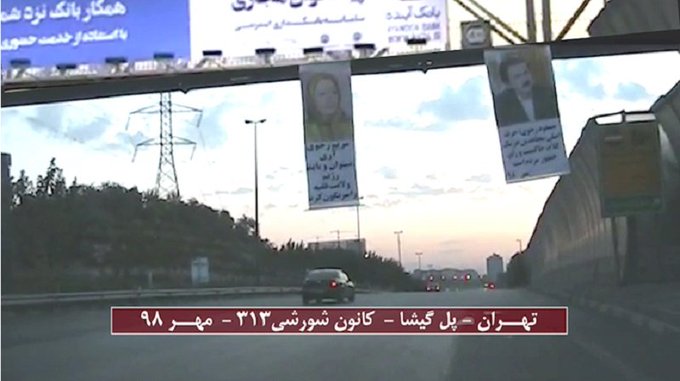Britain’s Daily Star: Iran regime ‘readying for war’ with missile cities buried under concrete

Iran's regime is stepping up its preparations for war at its sprawling underground missile bases hidden beneath five layers of concrete, Britain's Daily Star reports.
The National Council of Resistance of Iran (NCRI) provided the Daily Star with previously unseen images of the regime’s missile sites which are littered across Iran.
Hidden bases are said to be buried beneath up to five layers of concrete to fend off bomb blasts and missile strikes, Daily Star Online revealed.
"The largest of the sites is alleged to be the base at Khojir – known as Code 7500 – with a tunnel around 1,000 meters long packed with missiles," it wrote.
"Pictures have previously been revealed by Iranian state media of inside the bases."
"And now unseen aerial photos of some of the mysterious sites have been released to this website, sourced by People's Mojahedin Organization of Iran." The PMOI is also known as the Mujahedin-e Khalq or MEK.
Shahin Gobadi of the NCRI told the Daily Star the Iranian opposition estimates the Iranian regime has plowed “billions of dollars” into its missile program.
All you need to know about the #Iranian regime's clandestine nuclear program:#Iran’s Nuclear Weapons Programncr-iran.org/en/nuclear-iss…#IranDeal #IranNuclearDeal
See NCRI-FAC's other Tweets
He added since the signing of the now-canceled nuclear deal, the Iranian missile force has been stepping up its efforts with the purpose of “warmongering”.
"Iranian military forces burrowed out most of its sprawling tunnel complexes from between 1997 to 2002," the paper wrote.
"Despite a flurry of activity at the turn of the millennium, some sites are believed to date back as far as 1984."
The underground networks were built with the express intent of concealing missiles and to act as “launching sites to intimate and threaten” Iran's neighbors, Gobadi said.
Missile bases are primarily found around the Persian Gulf, but Code 7500 is found just outside Tehran, the Daily Star wrote.
It is alleged the Iranian regime used shell companies linked to the Revolutionary Guard – a powerful military faction in Tehran – to covertly construct the sites, the Star added.
Pictures provided to Daily Star Online by the NCRI show missile sites with tunnel complexes around Iran.
Images of Khojir show the military base with at least three roads appearing to go burrowing beneath a nearby hillside.
Code 7500 is believed to be the final construction site of the Shahab 3 medium-range missiles.
In western Iran, there is the Imam Ali base, which also has a road disappearing into a mountainside.
Finally, the Lar garrison is hewn into the terrain in western Iran – once again vanishing underground.
Lar is described by NCRI sources as a “sprawling tunnel complex” that is “highly protected and secure”.
It is this complex that is believed to have been featured in the regime propaganda – being dubbed the “missile city”.
Mobile phone signals are blocked around the base, the Daily Star added.
Other sites – such as the Queshm Missile Centre on the Iranian coast – are understood to be hidden under up to five layers of concrete.
Iran has allegedly used the facility to export missiles to its proxy forces in Yemen.
Mr. Gobadi told Daily Star Online: “In the span of more than three decades, the regime has invested billions of dollars in its missile force.
“To this effect, by devoting enormous resources, it has extensively used technology acquired from other countries, in particular from North Korea.”
He added: “The clerical regime stepped up its ballistic missile tests and forward positioning of exported missiles to the countries in the region, including Lebanon, Iraq, Syria, and Yemen, for warmongering purposes, subsequent to the signing the nuclear agreement in July 2015.”
Iran's regime is believed to use a network of proxy forces to supply weapons to terrorist forces to cause chaos in the Middle East.
And Iran's regime has been roundly blamed by the West for the recent attack on Saudi Arabian oil facilities which brought the Middle East to the brink of a third Gulf War.
NCRI sources said the exact number of missiles in the regime’s arsenal remains unknown.
Mr. Gobadi told Daily Star Online: “From its inception, the clerical regime has relied on domestic repression and export of terrorism and warmongering in the region as two pillars of its survival.
“The missile program is an integral part of this belligerent strategy.
“Crises from all directions have engulfed the Iranian regime, including ongoing protests and strikes as well as an upsurge in activities by resistance units of the People’s Mojahedin Organization of Iran (MEK) at home.
“As popular resistance inevitably weakens and isolates the regime domestically, it will step up its activities to export terrorism and its brand of Islamic fundamentalism to distract from the Iranian people’s aspirations for regime change.
#MEK Resistance Units have in recent weeks stepped up daring anti-regime activities including installing banners &posters supporting opposition leaders #MassoudRajavi and #MaryamRajavi and calling for #IranRegimeChange the #Iranian people.#FreeIranncr-iran.org/en/news/iran-r…
71 people are talking about this
“The regime is unlikely to stop exporting terrorism and Islamic fundamentalism as it will lose its reason for existence and driving force, thus accelerating its downfall.”
Britain’s foreign secretary Dominic Raab said the UK Government has also concluded Iran was behind the attack on Saudi Arabia.















No comments:
Post a Comment